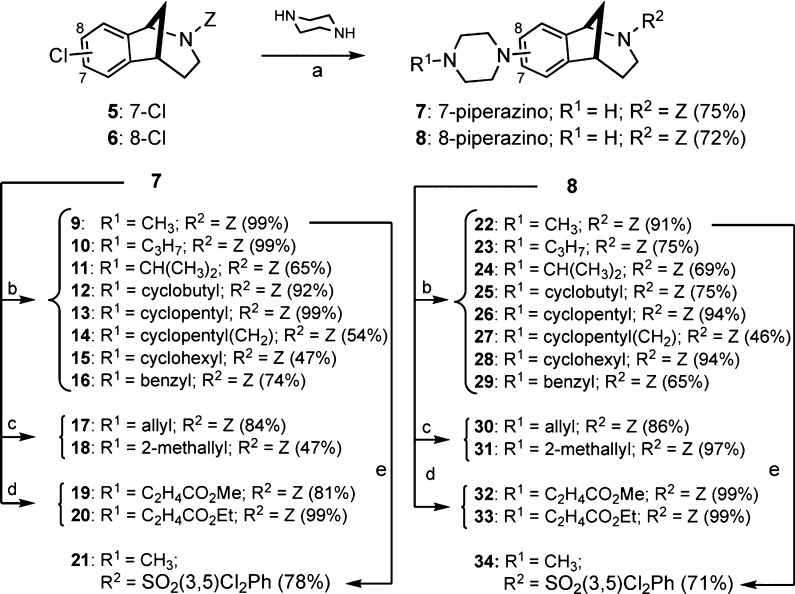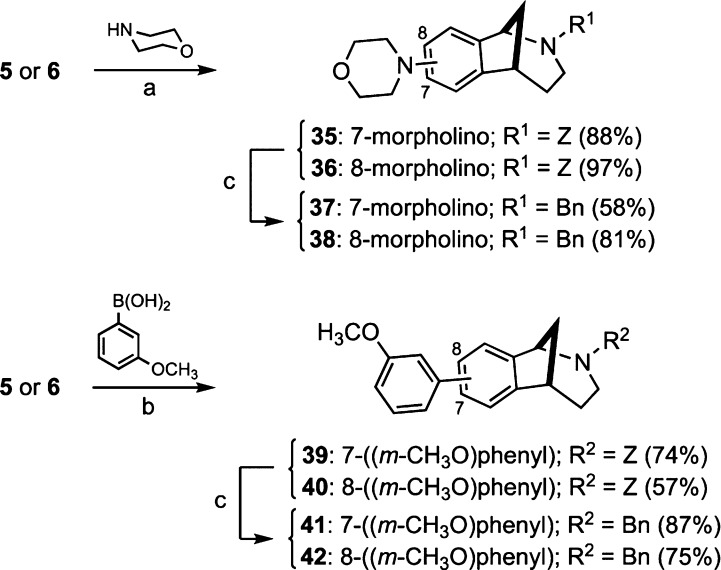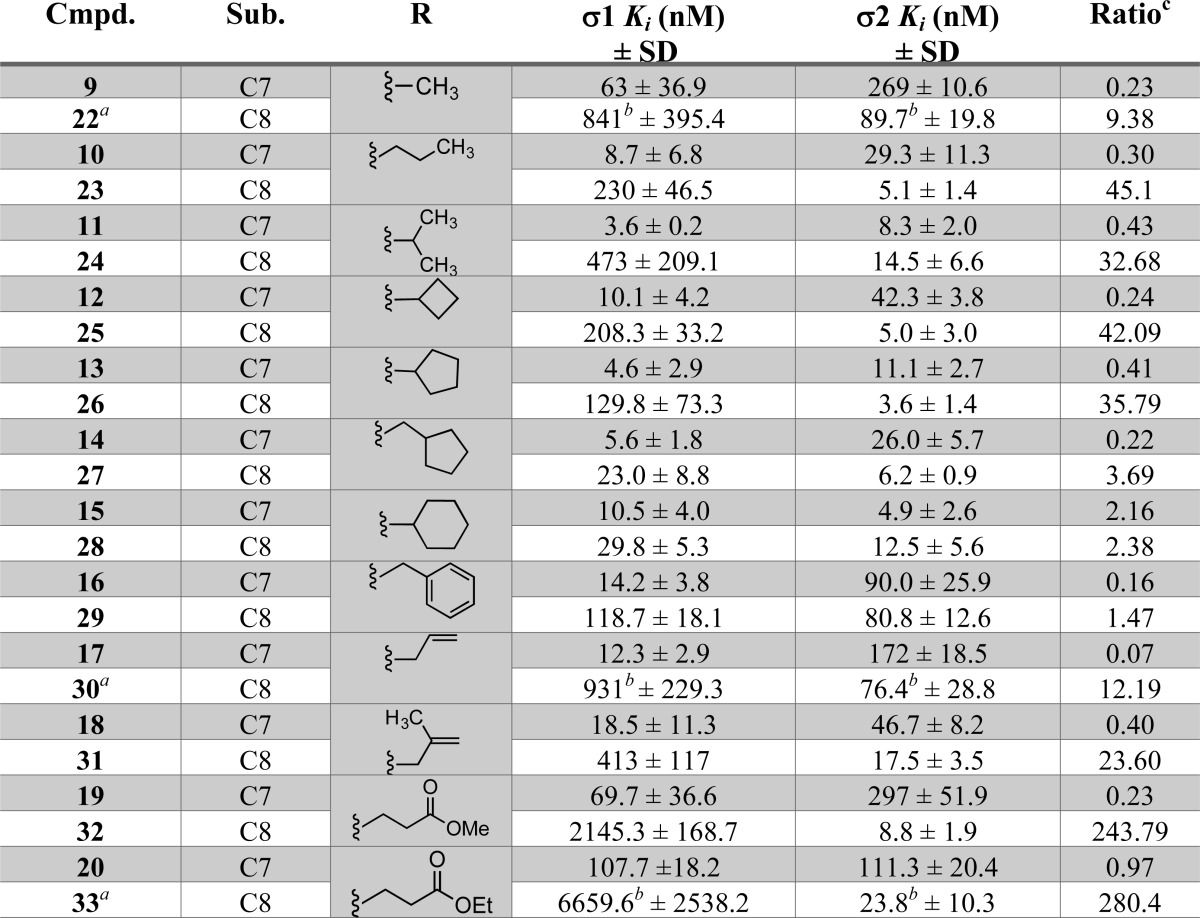Abstract

Some norbenzomorphans exhibit high affinity for sigma 1 and sigma 2 receptors, and varying the position of substituents on the aromatic ring of this scaffold has a significant effect on subtype selectivity. In particular, compounds bearing several different substituents at C7 of the norbenzomorphan ring system exhibit a general preference for the sigma 1 receptor, whereas the corresponding C8-substituted analogues preferentially bind at the sigma 2 receptor. These findings suggest that the norbenzomorphan scaffold may be a unique chemical template that can be easily tuned to prepare small molecules for use as tool compounds to study the specific biological effects arising from preferential binding at either sigma receptor subtype. In the absence of structural characterization data for the sigma 2 receptor, such compounds will be useful toward refining the pharmacophore model of its binding site.
Keywords: Sigma receptor, norbenzomorphan, neuroprotection, Alzheimer’s disease, traumatic brain injury
Sigma receptors (σRs) are a distinct class of transmembrane proteins that are expressed in the central nervous system (CNS) and peripheral tissues. They are involved in a variety of critical cellular processes, including Ca2+ regulation, apoptosis, and neuron survival.1 Originally classified as an opioid receptor subtype and subsequently as a phencyclidine/N-methyl-d-aspartate binding site,2 σRs are now known to be non-GPCR proteins that comprise two receptor subtypes, the sigma 1 (σ1) receptor and the sigma 2 (σ2) receptor. The subtypes are differentiated by their molecular weight, anatomical distribution, and preference for specific ligands.1 Although there are several reports of assays that may be used to assign functional activity for ligands of each σ receptor subtype,3,4 these protocols have not yet been widely adopted and adequately vetted.
The σ1 receptor has been cloned and sequenced, and recently a crystal structure of the ligand-bound protein was obtained.5 The σ1 receptor is expressed in the olfactory bulb and hypothalamus, and it shows >90% identity between mouse, rat, and human.6 This receptor is involved in regulation of K+ and Ca2+ levels, as well as modulation of neuronal firing and neurotransmitter release. A multitude of ligands are known that bind to the σ1 receptor,7 and several drug candidates that bind to σ1 receptors are in clinical trials for Alzheimer’s disease (AD),8 epilepsy,6 and pain.9 Moreover, drugs such as donepezil, fluvoxamine,10 and opipramol11 have high affinity for the σ1 receptor and are in current use. Although the exact therapeutic contribution of σ1 receptor binding for these drugs is not clear, some data ascribes clinical efficacy, in part, to σ1 receptor activation.
Unlike the σ1 receptor, cloning of the σ2 receptor has not yet been reported. Several accounts suggest that the putative σ2 receptor binding site is in the progesterone receptor membrane component 1 (PGRMC1) protein complex.12,13 However, others propose that the σ2 receptor and PGRMC1, which is a heme binding protein that has been well characterized,14,15 are distinct molecular entities.16−18 Although additional research is needed to clarify the nature of the relationship between the σ2 receptor and PGRMC1, we have recently shown that some high affinity σ2 receptor ligands act through a vem-1 (PGRMC1 ortholog) pathway in C. elegans.19
Subtype-selective σ2 receptor ligands have been shown to exhibit a range of clinically relevant properties, and these discoveries have inspired increasing interest in the σ2 receptor as a novel biological target. For example, the σ2 receptor is overexpressed in proliferating tumor cells and is a potential target for cancer diagnostics and chemotherapeutics.20,21 The σ2 receptor has also been shown to be involved in dopaminergic transmission, microglia activation, and neuroprotection.22 The σ2 receptor plays a key role in amyloid β (Aβ)-induced synaptotoxicity, and σ2 receptor binding ligands that block the interaction of Aβ oligomers with the σ2 receptor have been shown to be neuroprotective.23,24 We have shown that σ2 receptor modulators improve cognitive performance in transgenic AD mice as well as wild-type mice,19 and we recently discovered that σ2 receptor modulators improve learning and memory in mice following a blast-induced brain injury.25
Numerous subtype selective σ receptor ligands with a broad array of structural diversity have been disclosed,26 including the granatanes 1, aminoaryl esters 2, benzomorphans 3, norbenzomorphans 4 (Figure 1), and others.27,28 However, we are not aware of any compound classes wherein making a small structural change to a ligand having high affinity for one σ receptor subtype results in a significant reversal of subtype selectivity. It is thus noteworthy that we have now discovered pairs of regioisomeric norbenzomorphans that exhibit a remarkable change in preference for σ receptor subtype based on the location of the substituent (C7 vs C8) on the norbenzomorphan framework. Because such pairs of ligands have identical molecular properties and are likely to exhibit similar physicochemical characteristics, they are potentially useful as complementary chemical tools to study the effects of modulating each receptor subtype.
Figure 1.
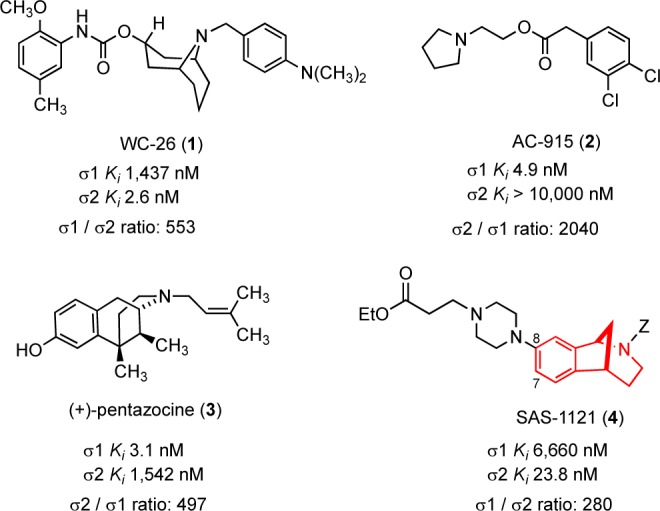
High affinity σ1 and σ2 receptor ligands 1–4.
We recently developed a general platform for the rapid synthesis of small collections of functionalized heterocyclic scaffolds that can be further diversified by facile cross-coupling reactions and refunctionalizations.29−33 Because of the drug-like properties34,35 and potential medicinal applications of norbenzomorphan derivatives,36,37 we were attracted to this tricyclic skeletal framework (4, Figure 1, red highlight). Studies of the receptor binding profiles for a small set of norbenzomorphan derivatives against a panel of CNS-based proteins, which were performed at the NIMH-PDSP,38 revealed that many of these compounds exhibit high affinity for the σ1 and σ2 receptors. These data reveal that compounds having a substituent at C8 of the norbenzomorphan nucleus tend to be selective for the σ2 receptor relative to the σ1 receptor, whereas those having substituents at C7 bind preferentially to the σ1 receptor. We recently expanded on these early findings and disclosed a series of C8-substituted analogues of SAS-1121 (4, Figure 1) that bind to the σ2 receptor with high affinity and significant selectivity over the σ1 receptor.39 We now report that σ receptor subtype selectivity for a series of regioisomeric norbenzomorphans can vary dramatically depending upon whether the substituent is at the C7- or C8-position of the norbenzomorphan ring.
In order to prepare an assortment of C7- and C8-substituted norbenzomorphans for receptor subtype profiling, the aryl chlorides 5 and 6 were synthesized on a multigram scale via a multicomponent assembly process described previously.33 The Buchwald–Hartwig cross-coupling reaction of 5 and 6 with piperazine in the presence of Pd(OAc)2 delivered the corresponding arylpiperazines 7 and 8 (Scheme 1). These key intermediates were then independently elaborated to a series of tertiary amines using standard N-alkylation reactions. Because the presence of an ionizable nitrogen atom appears to be an essential requirement for high affinity binding to σ receptors,40,41 transformations that significantly attenuate the basicity of the amino group (i.e., acylations, sulfonylations, etc.) were avoided. Thus, reductive amination of 7 and 8 with a series of aldehydes and ketones in the presence of Na(OAc)3BH gave the tertiary amines 9–16 and 22–29. The allylamine analogues 17, 18, 30, and 31 were conveniently prepared by N-allylation of 7 and 8 with the appropriate allyl halides. Reaction of 7 and 8 with methyl or ethyl acrylate delivered the corresponding β-amino esters 19, 20, 32, and 33 in high yield. Finally, the dichlorophenylsulfonamides 21 and 34 were prepared from 7 and 8 by removal of the carbamate group using iodotrimethylsilane (TMSI) followed by aqueous acid workup and N-arylsulfonylation.
Scheme 1. Synthesis of Arylpiperazine Analogues 7–34.
Two sets of regioisomers having substituents other than a piperazine ring were also prepared to ascertain whether reversal of subtype selectivity may be a more general phenomenon and not simply confined to piperazine analogues. Accordingly, the derivatives 35 and 36 were prepared from 5 and 6 via Buchwald–Hartwig cross-coupling reactions using morpholine as a reaction partner (Scheme 2), while the biaryls 39 and 40 were synthesized from 5 and 6 by a Suzuki reaction using 3-methoxyphenylboronic acid in the presence of catalytic Pd[P-tBu3]2 (Scheme 2). The carbamates 35, 36, 39, and 40 were then transformed into the corresponding benzylamines 37, 38, 41, and 42 by reaction with TMSI, followed by workup with aqueous base.
Scheme 2. Preparation of Morpholines and Biaryls 35–42.
This new collection of C7- and C8-substituted norbenzomorphans was then submitted to the PDSP in order to determine their binding profiles at σ receptors as well as at 38 other CNS receptors using competition binding assays with radiolabeled ligands (see Table S1 in Supporting Information for binding profiles of representative compounds at non-σ receptor sites).42 The σ receptor binding profiles, which are reported as binding affinities (Kis), were obtained for 15 pairs of regioisomers (Tables 1 and 2). These results reveal that the location of the substituent on the norbenzomorphan ring has a striking effect upon σ receptor subtype affinity. The C7-substituted analogues are generally selective for the σ1 receptor, with the most selective ligand 37 having 34-fold preference for the σ1 receptor versus the σ2 receptor (Table 1). Conversely, the corresponding C8-substituted norbenzomorphans display remarkable selectivity for the σ2 receptor over the σ1 receptor. Indeed, the C8-substituted ligands 32 and 33 have >200-fold selectivity for the σ2 receptor over the σ1 receptor (Table 1). These trends are summarized in Figure 2.
Table 1. Sigma Receptor Binding Affinities of Carbamate Norbenzomorphans.

Ki values reported as an average of two or more independent experiments.
Compound previously published.39
Differs from previously published values due to averaging of additional Ki measurements.
Ratio equal to σ1 Ki/σ2 Ki.
Table 2. Sigma Receptor Binding Affinities of Sulfonamide- and Benzylamine Norbenzomorphans.
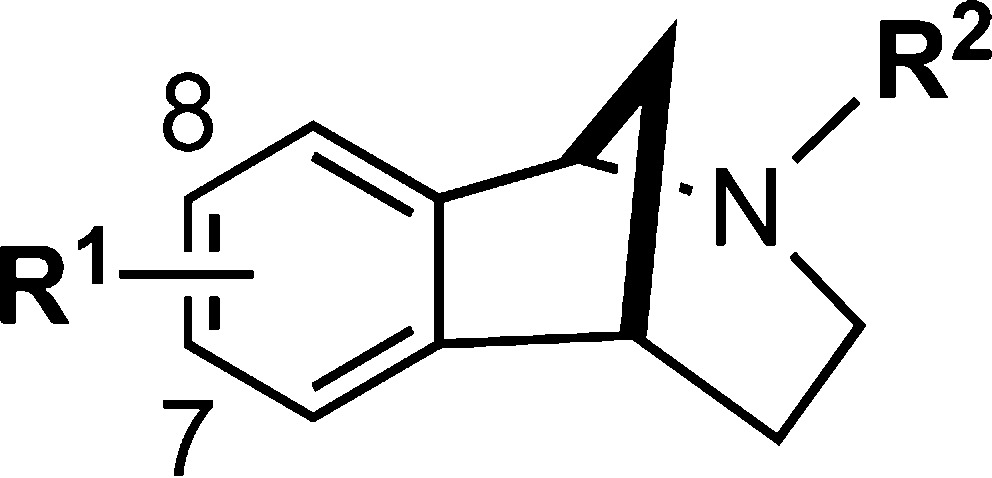
Ki values reported as an average of two or more independent experiments.
Compound previously published.39
Differs from previously published values due to averaging of additional Ki measurements.
Ratio equal to σ1 Ki/σ2 Ki.
Figure 2.
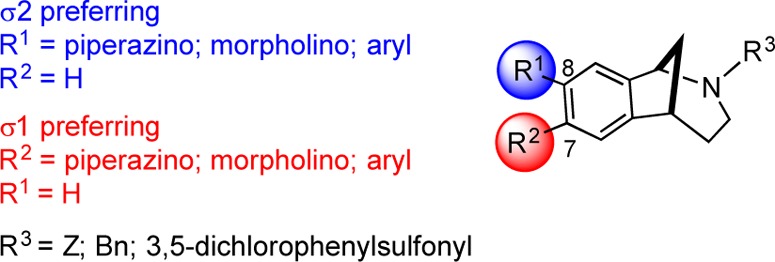
Location of C-aryl substituent on norbenzomorphan regulates σ receptor subtype selectivity.
A more detailed analysis of the findings summarized in Table 1 reveals some notable trends within the various groups of C7- and C8-substituted analogues. Among the alkylpiperazine analogues having a benzyl carbamate group (9–33), the C7 regioisomers exhibit selectivity for the σ1 receptor versus the σ2 receptor, whereas the C8 regioisomers are selective for the σ2 receptor. It is noteworthy, however, that the C8 regioisomers exhibit subtype selectivity superior to that of the corresponding C7 regioisomers. Among the saturated, acyclic alkylpiperazines 9–11 and 22–24, an increase in hydrophobicity arising from a change in the N-alkyl group (i.e., from N-methyl, N-propyl-, and N-isopropyl) leads to enhanced σ1 receptor affinity for C7 regioisomers and increased σ2 receptor affinity for C8 regioisomers. Interestingly, increasing the hydrophobic bulk of this substituent within the C8 series is accompanied by an increase in σ2 receptor subtype selectivity, but there is no notable effect in the C7 series. σ receptor subtype selectivity of allylpiperazine analogues 17, 18, 30, and 31 is also governed by the location of the piperazine substituent on the norbenzomorphan scaffold. A change from allyl to 2-methallyl affords an increase in σ receptor affinity for both sets of regioisomers. However, only the C8-regioisomers exhibit a corresponding increase in σ2 receptor subtype selectivity; C7 regioisomers suffer a decrease in σ1 receptor subtype selectivity when allyl is replaced with 2-methallyl. The piperazine derivatives 12–14, 16, and 25–29, which bear N-(methyl)cycloalkyl- and N-benzyl groups, follow the same trends in receptor subtype selectivity. However, the C7-substituted cyclohexylpiperazine 15, which appears to show a slight preference for the σ2 receptor, is an exception to this trend.
The effects observed upon introducing a polar residue into the N-alkyl side chain of the piperazine analogues warrants some commentary. The C7 piperazine methyl ester 19 exhibits a slight preference for the σ1 receptor over the σ2 receptor, whereas the corresponding ethyl ester 20 is equipotent at both σ receptor subtypes rather than favoring the σ1 receptor as might have been expected. In marked contrast, the corresponding C8 substituted analogues 32 and 33 boast dramatic enhancements in σ2 receptor subtype selectivity. Namely, the methyl ester 32 exhibits greater than 240-fold selectivity for the σ2 receptor, and the ethyl ester 33 (SAS-1121) is 280-fold selective for the σ2 receptor over the σ1 receptor.
Several pairs of regioisomers having other N-, C7-, and C8-substituents were examined in preliminary experiments to assess the importance of these moieties for σ receptor subtype selectivity. The N-sulfonamide regioisomers 21 and 34 follow the observed trend in subtype selectivity with the C7-substituted isomer 21 being selective for the σ1 receptor, and the C8-isomer 34 favoring the σ2 receptor (Table 2). The morpholino isomers 37 and 38 exhibit the same tendency toward σ receptor subtype selectivity as do their biaryl counterparts 41 and 42. These examples suggest that the observed regioisomer-driven subtype selectivity may be a general phenomenon that can be achieved by appending a variety of substituents on the aromatic ring and the nitrogen atom of the norbenzomorphan scaffold.
In summary, we have identified a new class of σ receptor binding ligands for which the receptor subtype selectivity can be readily modulated by simply varying the position of a substituent at C7 and C8 of the norbenzomorphan scaffold. There appears to be a certain degree of flexibility for the nature of the substituent on both the aromatic ring and the nitrogen atom of the norbenzomorphan scaffold: The aryl ring may be decorated with piperazine, morpholine, or aryl groups, whereas the nitrogen atom may be adorned with aryl carbamates, sulfonamides, and benzyl groups. As a rule, C7-substituted regioisomers bind preferentially to the σ1 receptor relative to the σ2 receptor, whereas C8-substituted ligands favor the σ2 receptor over the σ1 receptor. The ease with which norbenzomorphan derivatives can be tuned for preferential binding at either σ receptor subtype is unprecedented and suggests that various norbenzomorphan analogues might serve as subtype-selective chemical tools to study the structure and function of σ receptors. We are currently engaged in efforts to clone and structurally characterize the σ2 receptor. However, in the absence of structural information for the σ2 receptor, the data presented herein will prove useful for enhancing current pharmacophore models40,41 for the σ receptors.
Acknowledgments
We are grateful to Dr. Richard Pederson (Materia, Inc.) for catalyst support. Determinations of receptor binding profiles were generously provided by the Psychoactive Drug Screening Program (PDSP) of the US National Institute of Mental Health (NIMH) (contract # HHSN-271-2013-00017-C). The NIMH–PDSP is Directed by Bryan L. Roth MD, PhD at the University of North Carolina at Chapel Hill and Project Officer Jamie Driscoll at NIMH, Bethesda MD, USA. We thank Dr. James Myslinski for technical support.
Glossary
ABBREVIATIONS
- AD
Alzheimer’s disease
- Aβ
amyloid beta
- C. elegans
Caenorhabditis elegans
- JohnPhos
(2-biphenyl)di-tert-butylphosphine
- Ki
inhibition constant
- PDSP
Psychoactive Drug Screening Program
- PGRMC1
progesterone receptor membrane component 1
- SD
standard deviation
Supporting Information Available
The Supporting Information is available free of charge on the ACS Publications website at DOI: 10.1021/acsmedchemlett.7b00066.
Representative experimental procedures and full characterization data (1H and 13C NMR, IR, and HRMS) for all new compounds (PDF)
Author Contributions
The manuscript was written through contributions of all authors. All authors have approved the final version of the manuscript.
Generous funding for this research was provided by The Robert A. Welch Foundation (F-0652), the National Institutes of Health (GM 86192), the donors of the ADR, a program of the BrightFocus Foundation, and the Dell Medical School’s Texas Health Catalyst program.
The authors declare no competing financial interest.
Supplementary Material
References
- Matsumoto R. R., Bowen W. D., Su T. -P., Eds. Sigma Receptors: Chemistry, Cell Biology, and Clinical Implications; Springer: New York, 2007. [Google Scholar]
- Martin W. R.; Eades C. E.; Thompson J. A.; Huppler R. E.; Gilbert P. E. The effects of morphine- and nalorphine-like drugs in the nondependent and morphine-dependent chronic spinal dog. J. Pharmacol. Exp. Ther. 1976, 197, 517–532. [PubMed] [Google Scholar]
- Cobos E. J.; Baeyens J. M.; Del Pozo E. Phenytoin differentially modulates the affinity of agonist and antagonist ligands for sigma 1 receptors of guinea pig brain. Synapse 2005, 55, 192–195. 10.1002/syn.20103. [DOI] [PubMed] [Google Scholar]
- Zeng C.; Rothfuss J. M.; Zhang J.; Vangveravong S.; Chu W.; Li S.; Tu Z.; Xu J.; Mach R. H. Functional assays to define agonists and antagonists of the sigma-2 receptor. Anal. Biochem. 2014, 448, 68–74. 10.1016/j.ab.2013.12.008. [DOI] [PMC free article] [PubMed] [Google Scholar]
- Schmidt H. R.; Zheng S.; Gurpinar E.; Koehl A.; Manglik A.; Kruse A. C. Crystal structure of the human σ1 receptor. Nature 2016, 532, 527–530. 10.1038/nature17391. [DOI] [PMC free article] [PubMed] [Google Scholar]
- Hayashi T.; Su T.-P. The sigma receptor: Evolution of the concept in neuropsychopharmacology. Curr. Neuropharmacol. 2005, 3, 267–280. 10.2174/157015905774322516. [DOI] [PMC free article] [PubMed] [Google Scholar]
- Manohar M.; Banister S.; Beinat C.; O’Brien-Brown J.; Kassiou M. Recent advances in the development of sigma-1 receptor ligands. Aust. J. Chem. 2015, 68, 600–609. 10.1071/CH14590. [DOI] [Google Scholar]
- See http://www.anavex.com/pipeline/.
- Vela J. M.; Merlos M.; Almansa C. Investigational sigma 1 receptor antagonists for the treatment of pain. Expert Opin. Invest. Drugs 2015, 24, 883–896. 10.1517/13543784.2015.1048334. [DOI] [PubMed] [Google Scholar]
- Narita N.; Hashimoto K.; Tomitaka S.-I.; Minabe Y. Interactions of selective serotonin reuptake inhibitors with subtype σ receptors in rat brain. Eur. J. Pharmacol. 1996, 307, 117–119. 10.1016/0014-2999(96)00254-3. [DOI] [PubMed] [Google Scholar]
- Möller H. J.; Volz H. P.; Reimann I. W.; Stoll K. D. Opipramol for the treatment of generalized anxiety disorder. A placebo-controlled trial including an alprazolam treated group. J. Clin. Psychopharmacol. 2001, 21, 59–65. 10.1097/00004714-200102000-00011. [DOI] [PubMed] [Google Scholar]
- Xu J.; Zeng C.; Chu W.; Pan F.; Rothfuss J. M.; Zhang F.; Tu Z.; Zhou D.; Zeng D.; Vangveravong S.; Johnston F.; Spitzer D.; Chang K. C.; Hotchkiss R. S.; Hawkins W. G.; Wheeler K. T.; Mach R. H. Identification of the PGRMC1 protein complex as the putative sigma-2 receptor binding site. Nat. Commun. 2011, 2, 380. 10.1038/ncomms1386. [DOI] [PMC free article] [PubMed] [Google Scholar]
- Zeng C.; Garg H.; Mach R. H. The PGRMC1 protein level correlates with the binding activity of a sigma 2 fluorescent probe (SW120) in rat brain cells. Mol. Imaging Biol. 2016, 18, 172–179. 10.1007/s11307-015-0891-z. [DOI] [PubMed] [Google Scholar]
- Kabe Y.; Nakane T.; Koike I.; Yamamoto T.; Sugiura Y.; Harada E.; Sugase K.; Shimamura T.; Ohmura M.; Muraoka K.; Yamamoto A.; Uchida T.; Iwata S.; Yamaguchi Y.; Krayukhina E.; Noda M.; Handa H.; Ishimori K.; Uchiyama S.; Kobayashi T.; Suematsu M. Haem-dependent dimerization of PGRMC1/sigma-2 receptor facilitates cancer proliferation and chemoresistance. Nat. Commun. 2016, 7, 11030. 10.1038/ncomms11030. [DOI] [PMC free article] [PubMed] [Google Scholar]
- Cahill M. A. Progesterone receptor membrane component 1: an integrative review. J. Steroid Biochem. Mol. Biol. 2007, 105, 16–36. 10.1016/j.jsbmb.2007.02.002. [DOI] [PubMed] [Google Scholar]
- Abate C.; Niso M.; Infantino V.; Menga A.; Berardi F. Elements in support of the ’non-identity’ of the PGRMC1 protein with the sigma2 receptor. Eur. J. Pharmacol. 2015, 758, 16–23. 10.1016/j.ejphar.2015.03.067. [DOI] [PubMed] [Google Scholar]
- Chu U. B.; Mavlyutov T. A.; Chu M.-L.; Yang H.; Schulman A.; Mesangeau C.; McCurdy C. R.; Guo L.-W.; Ruoho A. E. The sigma-2 receptor and progesterone receptor membrane component 1 are different binding sites derived from independent genes. EbioMed. 2015, 2, 1806–1813. 10.1016/j.ebiom.2015.10.017. [DOI] [PMC free article] [PubMed] [Google Scholar]
- Pati M. L.; Groza D.; Riganti C.; Kopecka J.; Niso M.; Berardi F.; Hager S.; Heffeter P.; Hirai M.; Tsugawa H.; Kabe Y.; Suematsu M.; Abate C. Sigma-2 receptor and progesterone receptor membrane component 1(PGRMC1) are two different proteins: Proofs by fluorescent labeling and binding of sigma-2 receptor ligands to PGRMC1. Pharmacol. Res. 2017, 117, 67–74. 10.1016/j.phrs.2016.12.023. [DOI] [PubMed] [Google Scholar]
- Yi B.; Sahn J. J.; Ardestani P. M.; Evans A. K.; Scott L.; Chan J. Z.; Iyer S.; Crisp A.; Zuniga G.; Pierce J.; Martin S. F.; Shamloo M. Small molecule modulator of sigma 2 receptor is neuroprotective and reduces cognitive deficits and neuro-inflammation in experimental models of Alzheimer’s disease. J. Neurochem. 2017, 140, 561–575. 10.1111/jnc.13917. [DOI] [PMC free article] [PubMed] [Google Scholar]
- Mach R. H.; Zeng C.; Hawkins W. G. The sigma2 receptor: A Novel Protein for the Imaging and Treatment of Cancer. J. Med. Chem. 2013, 56, 7137–7160. 10.1021/jm301545c. [DOI] [PMC free article] [PubMed] [Google Scholar]
- Huang Y. S.; Lu H. L.; Zhang L. J.; Wu Z. Sigma-2 receptor ligands and their perspectives in cancer diagnosis and therapy. Med. Res. Rev. 2014, 34, 532–566. 10.1002/med.21297. [DOI] [PubMed] [Google Scholar]
- Guo L.; Zhen X. Sigma-2 receptor ligands: neurobiological effects. Curr. Med. Chem. 2015, 22, 989–1003. 10.2174/0929867322666150114163607. [DOI] [PubMed] [Google Scholar]
- Izzo N. J.; Staniszewski A.; To L.; Fa M.; Teich A. F.; Saeed F.; Wostein H.; Walko T. III.; Vaswani V.; Wardius M.; Syed Z.; Ravenscroft J.; Mozzoni K.; Silky C.; Rehak C.; Yurko R.; Finn P.; Look G.; Rishton G.; Safferstein H.; Miller M.; Johanson C.; Stopa E.; Windisch M.; Hutter-Paier B.; Shamloo M.; Arancio O.; Levine H. III; Catalano S. M. Alzheimer’s therapeutics targeting amyloid beta 1–42 oligomers I: Abeta 42 oligomer binding to specific neuronal receptors is displaced by drug candidates that improve cognitive deficits. PLoS One 2014, 9, e111898. 10.1371/journal.pone.0111898. [DOI] [PMC free article] [PubMed] [Google Scholar]
- Izzo N. J.; Xu J.; Zeng C.; Kirk M. J.; Mozzoni K.; Silky C.; Rehak C.; Yurko R.; Look G.; Rishton G.; Safferstein H.; Cruchaga C.; Goate A.; Cahill M. A.; Arancio O.; Mach R. H.; Craven R.; Head E.; LeVine H. III.; Spires-Jones T. L.; Catalano S. M. Alzheimer’s therapeutics targeting amyloid beta 1–42 oligomers II: Sigma-2/PGRMC1 receptors mediate abeta 42 oligomer binding and synaptotoxicity. PLoS One 2014, 9, e111899. 10.1371/journal.pone.0111899. [DOI] [PMC free article] [PubMed] [Google Scholar]
- Sahn J. J.; Hodges T. R.; Wood M. D.; Scott L. L.; Yen R. C.; Pierce-Shimomura J.; Pieper A. A.; Yin T. C.; Price T.; Mejia G.; Ferragud A.; Sabino V.; Ardestani P. M.; Shamloo M.; Martin S. F. “Targeting Sig2R/PGRMC1 for treating neurological disorders” (abstract 765.06) presented during the session entitled “Sigma-2/PGRMC1 receptor function in disease and therapeutics” at the Society for Neuroscience annual conference “Neuroscience 2016”, San Diego, CA (USA), November 12–16, 2016. See: http://e.ctt.bz/e.asp?e=7CBE7D32-7FD5-4446-A08C-E9F289F04FC0.
- Narayanan S.; Bhat R.; Mesangeau C.; Poupaert J. H.; McCurdy C. R. Early development of sigma-receptor ligands. Future Med. Chem. 2011, 3, 79–94. 10.4155/fmc.10.279. [DOI] [PubMed] [Google Scholar]
- Sun H.; Shi M.; Zhang W.; Zheng Y.-M.; Xu Y.-Z.; Shi J.-J.; Liu T.; Gunosewoyo H.; Pang T.; Gao Z.-B.; Yang F.; Tang J.; Yu L.-F. Development of novel alkoxyisoxazoles as sigma-1 receptor antagonists with antinociceptive efficacy. J. Med. Chem. 2016, 59, 6329–6343. 10.1021/acs.jmedchem.6b00571. [DOI] [PubMed] [Google Scholar]
- Bai S.; Li S.; Xu J.; Peng X.; Sai K.; Chu W.; Tu Z.; Zeng C.; Mach R. H. Synthesis and structure-activity relationship studies of conformationally flexible tetrahydroisoquinolinyl triazole carboxamide and triazole substituted benzamide analogues as σ2 receptor ligands. J. Med. Chem. 2014, 57, 4239–4251. 10.1021/jm5001453. [DOI] [PMC free article] [PubMed] [Google Scholar]
- Sunderhaus J. D.; Dockendorff C.; Martin S. F. Applications of multicomponent reactions for the synthesis of diverse heterocyclic scaffolds. Org. Lett. 2007, 9, 4223–4226. 10.1021/ol7018357. [DOI] [PubMed] [Google Scholar]
- Sunderhaus J. D.; Dockendorff C.; Martin S. F. Synthesis of diverse heterocyclic scaffolds via tandem additions to imine derivatives and ring-forming reactions. Tetrahedron 2009, 65, 6454–6469. 10.1016/j.tet.2009.05.009. [DOI] [PMC free article] [PubMed] [Google Scholar]
- Sahn J. J.; Granger B. A.; Martin S. F. Evolution of a strategy for preparing bioactive small molecules by sequential multicomponent assembly processes, cyclizations, and diversification. Org. Biomol. Chem. 2014, 12, 7659–7672. 10.1039/C4OB00835A. [DOI] [PMC free article] [PubMed] [Google Scholar]
- Sahn J. J.; Su J.; Martin S. F. Facile and unified approach to skeletally diverse, privileged scaffolds. Org. Lett. 2011, 13, 2590–2593. 10.1021/ol200709h. [DOI] [PMC free article] [PubMed] [Google Scholar]
- Sahn J. J.; Martin S. F. Expedient synthesis of norbenzomorphan library via multicomponent assembly process coupled with ring-closing reactions. ACS Comb. Sci. 2012, 14, 496–502. 10.1021/co300068a. [DOI] [PMC free article] [PubMed] [Google Scholar]
- Lipinski C. A.; Lombardo F.; Dominy B. W.; Feeney P. J. Experimental and computational approaches to estimate solubility and permeability in drug discovery and development settings. Adv. Drug Delivery Rev. 2001, 46, 3–26. 10.1016/S0169-409X(00)00129-0. [DOI] [PubMed] [Google Scholar]
- Veber D. F.; Johnson S. R.; Cheng H. Y.; Smith B. R.; Ward K. W.; Kopple K. D. Molecular properties that influence the oral bioavailability of drug candidates. J. Med. Chem. 2002, 45, 2615–2623. 10.1021/jm020017n. [DOI] [PubMed] [Google Scholar]
- Mokotoff M.; Jacobson A. E. Azabicyclo Chemistry. I. Synthesis of 1,5-methano-7-methoxy-2,3,4,5-tetrahydro-lH-2-benzazepines. B-Norbenzomorphans. J. Med. Chem. 1970, 13, 7–9. 10.1021/jm00295a002. [DOI] [PubMed] [Google Scholar]
- Chen Y. L.; Liston D.; Nielsen J.; Chapin D.; Dunaiskis A.; Hedberg K.; Ives J.; Johnson J. Jr.; Jones S. Syntheses and anticholinesterase activity of tetrahydrobenzazepine carbamates. J. Med. Chem. 1994, 37, 1996–2000. 10.1021/jm00039a013. [DOI] [PubMed] [Google Scholar]
- Binding affinities were determined through a competition binding assay in the presence of a radioligand; for a summary, see the Supporting Information.
- Sahn J. J.; Hodges T. R.; Martin S. F. Norbenzomorphan framework as a novel scaffold for generating sigma 2 subtype selective ligands. ChemMedChem 2016, 11, 556–561. 10.1002/cmdc.201500551. [DOI] [PMC free article] [PubMed] [Google Scholar]
- Jasper A.; Schepmann D.; Lehmkuhl K.; Vela J. M.; Buschmann H.; Holenz J.; Wünsch B. Synthesis of σ receptor ligands with unsymmetrical spiro connection of the piperidine moiety. Eur. J. Med. Chem. 2009, 44, 4306–4314. 10.1016/j.ejmech.2009.07.017. [DOI] [PubMed] [Google Scholar]
- Laurini E.; Zampieri D.; Mamolo M. G.; Vio L.; Zanette C.; Florio C.; Posocco P.; Fermeglia M.; Pricl S. A 3D-pharmacophore model for σ2 receptors based on a series of substituted benzo[d]oxazol-2(3H)-one derivatives. Bioorg. Med. Chem. Lett. 2010, 20, 2954–2957. 10.1016/j.bmcl.2010.03.009. [DOI] [PubMed] [Google Scholar]
- Receptor binding assays conducted at the Psychoactive Drug Screening Program, Chapel Hill, NC.
Associated Data
This section collects any data citations, data availability statements, or supplementary materials included in this article.



